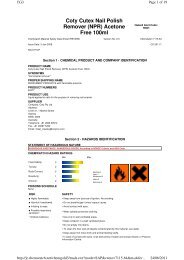Diversey Divermite D10 - ACT Health Supply Services
Diversey Divermite D10 - ACT Health Supply Services
Diversey Divermite D10 - ACT Health Supply Services
You also want an ePaper? Increase the reach of your titles
YUMPU automatically turns print PDFs into web optimized ePapers that Google loves.
CG3<br />
NAME CAS RN %<br />
monoethanolamine 141-43-5 10-30<br />
alcohol ethoxylates 10-30<br />
organic acid derivative 1-10<br />
quaternary ammonium compounds unspecified 1-10<br />
additives unregulated<br />
<strong>Diversey</strong> <strong>Divermite</strong> <strong>D10</strong><br />
water 7732-18-5 balance<br />
Section 4 - FIRST AID MEASURES<br />
Hazard Alert Code:<br />
HIGH<br />
Chemwatch Material Safety Data Sheet (REVIEW) Version No: 2.0 Chemwatch 4537-95<br />
Issue Date: 29-Jan-2010 CD 2011/1<br />
NC317TCP<br />
Page 2 of 10<br />
SWALLOWED<br />
■ Rinse mouth out with plenty of water.<br />
For advice, contact a Poisons Information Centre or a doctor.<br />
If swallowed do NOT induce vomiting.<br />
If vomiting occurs, lean patient forward or place on left side (head-down position, if possible) to maintain open airway and<br />
prevent aspiration.<br />
Observe the patient carefully.<br />
Never give liquid to a person showing signs of being sleepy or with reduced awareness; i.e. becoming unconscious<br />
Give water to rinse out mouth, then provide liquid slowly and as much as casualty can comfortably drink.<br />
Seek medical advice.<br />
EYE<br />
■ If this product comes in contact with the eyes:<br />
Immediately hold eyelids apart and flush the eye continuously with running water.<br />
Ensure complete irrigation of the eye by keeping eyelids apart and away from eye and moving the eyelids by occasionally lifting<br />
the upper and lower lids.<br />
Continue flushing until advised to stop by the Poisons Information Centre or a doctor, or for at least 15 minutes.<br />
Transport to hospital or doctor without delay.<br />
Removal of contact lenses after an eye injury should only be undertaken by skilled personnel.<br />
SKIN<br />
■ If skin contact occurs:<br />
Immediately remove all contaminated clothing, including footwear.<br />
Flush skin and hair with running water (and soap if available).<br />
Seek medical attention in event of irritation.<br />
INHALED<br />
■<br />
If fumes or combustion products are inhaled remove from contaminated area.<br />
Lay patient down. Keep warm and rested.<br />
Prostheses such as false teeth, which may block airway, should be removed, where possible, prior to initiating first aid<br />
procedures.<br />
Apply artificial respiration if not breathing, preferably with a demand valve resuscitator, bag-valve mask device, or pocket mask<br />
as trained. Perform CPR if necessary.<br />
Transport to hospital, or doctor.<br />
NOTES TO PHYSICIAN<br />
■ For acute or short-term repeated exposures to highly alkaline materials:<br />
Respiratory stress is uncommon but present occasionally because of soft tissue edema.<br />
Unless endotracheal intubation can be accomplished under direct vision, cricothyroidotomy or tracheotomy may be necessary.<br />
Oxygen is given as indicated.<br />
The presence of shock suggests perforation and mandates an intravenous line and fluid administration.<br />
Damage due to alkaline corrosives occurs by liquefaction necrosis whereby the saponification of fats and solubilisation of<br />
proteins allow deep penetration into the tissue.<br />
Alkalis continue to cause damage after exposure.<br />
INGESTION:<br />
Milk and water are the preferred diluents<br />
No more than 2 glasses of water should be given to an adult.<br />
Neutralising agents should never be given since exothermic heat reaction may compound injury.<br />
* Catharsis and emesis are absolutely contra-indicated.<br />
* Activated charcoal does not absorb alkali.<br />
* Gastric lavage should not be used.<br />
Supportive care involves the following:<br />
Withhold oral feedings initially.<br />
If endoscopy confirms transmucosal injury start steroids only within the first 48 hours.<br />
Carefully evaluate the amount of tissue necrosis before assessing the need for surgical intervention.<br />
Patients should be instructed to seek medical attention whenever they develop difficulty in swallowing (dysphagia).<br />
SKIN AND EYE:<br />
Injury should be irrigated for 20-30 minutes.<br />
Eye injuries require saline. [Ellenhorn & Barceloux: Medical Toxicology].<br />
http://jr.chemwatch.net/chemgold3/msds.exe?mode=SAP&cwno=4537-95&msdsfor...<br />
24/06/2011



